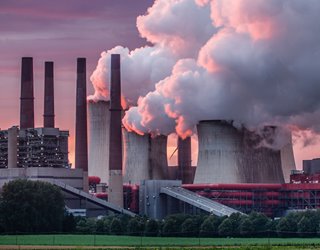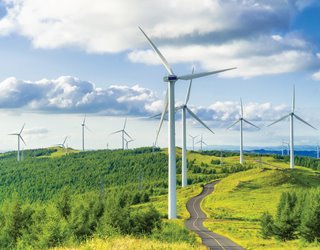How Do We Zero Out Carbon?
How Do We Zero Out Carbon?


The goal of eliminating power sector carbon emissions by 2035 is ambitious. But the bigger question is, how to replace all that lost fossil fuel generating capacity?
Proposals for building vast new infrastructure projects are fairly common. There are schemes from shooting trains through evacuated tubes to building human colonies on Mars—and that’s just Elon Musk. The November 2009 cover story in Scientific American authored by Stanford University engineering professor Mark Z. Jacobson and Mark A. Delucchi, a research scientist at the University of California, Davis, is part of that tradition. They showed how the entire world economy could be powered by wind, solar, and hydroelectricity. Fossil fuels, which had provided industrial nations the vast preponderance of energy for more than a century, were unnecessary by this reckoning and could be phased out.
The reaction was not altogether positive.
“People laughed at us at first,” Jacobson said. “We did develop a grandiose plan, admittedly. It was a worldwide plan, and nobody controls the world, so who can really implement this?”
Jacobson pugnaciously defended and expanded his proposal, but naysayers had some good points. In the mid-2000s, U.S. wind power accounted for just 9 GW and couldn’t be built for less than $2,000 per installed kilowatt (in inflation adjusted dollars). Solar power was even more uncompetitive, with utility-scale arrays of photovoltaic panels costing between $4,000 and $10,000 per installed kilowatt, adjusted for inflation. Neither could compete with low-cost conventional power stations. It was easy to dismiss anyone advocating a wholesale switch to renewables as deeply unserious. If society was going to transition away from fossil fuels, the thinking went, it would have to be via a massive spree of nuclear power plant construction.
But something came between the Jacobson and Delucchi article and obscurity: the decade of the 2010s. The evidence for climate change became even more compelling, and the cost of wind and solar power became astonishingly cheap. That fringe proposal started to become common sense. Decarbonizing the energy system was the topic of a National Academy of Science, Engineering, and Medicine (NASEM) report published in February 2021.
“The U.S. has more than sufficient renewable resources to power the whole country,” said Christian Sattler, an engineering professor at the Technical University of Dresden and a member of ASME’s Clean Energy Technical Group. “PV and wind are the most obvious ones but all other forms like hydro, solar thermal, biomass, waste, tidal and waves, or geothermal are also available.”
Joseph Biden proposed zeroing out carbon emissions from the electric power industry by 2035 during his presidential campaign. It is too early to say how the Biden campaign proposal will translate into Biden administration policy, but the eventual shuttering of most coal- and gas-fired power plants—once seen as both politically impossible and profoundly irresponsible—now seems all but inevitable.
The question is now, how do we replace all that power?
At the beginning of the 21st century, the electric industry was dominated by coal thermal power plants built decades before. In the late 1970s and 1980s, oil (which had been in second place as late as 1978) had rocketed in price, natural gas was being reserved for home heating, and coal plants were faster to build than nuclear reactors. Due to the Power Plant and Industrial Fuels Act of 1978, every new power plant was required to be capable of using coal.
Recommended for You: How 5 Countries Work Toward Decarbonization
As of 2010, according to a report by the U.S. Energy Information Administration, the coal-generating fleet built in the 1970s and 1980s had a nameplate capacity of 190 GW. That was nearly equal to the entire capacity of all existing hydroelectric power stations and nuclear power plants, combined.
Beginning in the mid-1990s, another kind of power plant began being built at large scale: gas-fueled plants capable of ramping up and down quickly to provide power during demand peaks. U.S. electricity market deregulation decoupled the ownership of generating stations from that of transmission and distribution, so adding power in smaller increments made economic sense. Between 1995 and 2005, more than 220 GW of natural gas generating capacity was added, though those plants were not expected to operate fulltime. Later, the influx of cheap shale gas spurred additional construction of new natural gas plants and the conversion to gas of some existing coal power stations.
Those two building sprees—one for coal plants in the 1970s and 1980s, and one for natural gas plants between 1995 and 2015—created a mix of generating assets heavily weighted toward fossil fuels. Today, the carbon emissions from the electricity generation sector, which accounts for 30 percent of all U.S. carbon dioxide emissions according to the U.S. Environmental Protection Agency, are dominated by coal-fired power plants (974 million tons per year, according to 2019 data) and natural gas plants (616 million tons per year). But the mix has also created an opportunity, said Emily Grubert, an assistant professor of civil and environmental engineering at Georgia Institute of Technology in Atlanta. The closure of existing power plants, which is implicit in the plan to eliminate power sector carbon dioxide emissions, could well be accomplished via natural attrition, she said.
“For about a nine-year period, coal plants were pretty much all you could build,” Grubert said. “That tends to coincide with about a lifespan ago.”
Grubert looked at the age of U.S. generating assets compared to their expected operating lives for a December 2020 article in Science. Typically, coal-fired steam-turbine plants operated for 50 years and gas turbine plants last 30 years, though asset operators will keep them running as long as they are profitable. When she plotted the retirement dates on a timeline, Grubert could see that the coal plants built in the 1970s and early 1980s would reach retirement in the 2020s and early 2030s; similarly, the gas plants that went online between 1995 and 2005 would age out between 2025 and 2035.
In all, 64 percent of all existing fossil fuel-fired generating capacity would reach the end of its typical lifespan by 2035, and about half of the remaining plants by capacity would be slated to close five years after that. In terms of emissions, the impact of natural retirements is even greater: plants accounting for 73 percent of emissions are scheduled for retirement by 2035; it rises to 84 percent by 2040.
The nearly synchronized retirements of a huge chunk of the generating fleet would be a crisis under normal conditions, but in relation to the call to eliminate carbon emissions, it provides options. For instance, Grubert said, there is the potential to close fossil-fuel plants by letting them retire gracefully and avoid costly buyouts.
“The people who work there are not going to be excited about closures,” she said. “But if that shutdown happens at about the same time as you would have expected when the plant was built, based on what other similar plants have been able to do, then I would argue that there’s not a case for compensation in that case to the same degree.”
That is not to say that the fossil fuel industries will give up without a fight, but the bigger challenge may be how to build carbon-free power systems on a scale to replace the fossil fuel power capacity that exists today.
Some 20 years ago, many engineers looked at wind and solar power as a sideline—expensive toys, glorified pinwheels—and not up to the challenge of providing utility-scale power for a country like the United States. Hardly anyone believes that now. The recent report published by the National Academies of Science, Engineering, and Medicine, "Accelerating Decarbonization of the U.S. Energy System," called for doubling the share of electricity generated by carbon-free sources in just 10 years, to 75 percent. (The report looks at the larger goal for decarbonizing the entire U.S. economy by 2050.) As the NASEM report itself states, “New wind and solar now offer the cheapest levelized cost of electricity over most of earth’s surface.”
The levelized cost of energy, or LCOE, is the average net cost to build and operate a facility compared to net energy that facility will produce over its lifetime, to reflect the break-even electricity price. As recently as 2009, the LCOE for a new wind turbine selling into an unsubsidized market was around $135 per MWh, according to an analysis by the Wall Street investment firm Lazard. That compared unfavorably to new nuclear power, with an LCOE of $123 per MWh, new coal plants with $111, and a new natural gas-fired combined cycle plant that cost only $83. Power from new photovoltaic panels was an even worse deal, with an LCOE of $359 per MWh.
The intervening 12 years have not altered the economics of new coal plants, and combined cycle gas turbine plants have gotten cheaper to build and operate thanks to historically low natural gas prices. “But the price for generating clean, low-carbon energy have been crashing,” said Timothy Lieuwen, professor of aerospace and mechanical engineering at Georgia Tech and one of the authors of the NASEM report.
In 2020, Lazard found that the LCOE of an onshore wind turbine facility ranged between $26 and $54 per MWh, a 70 percent drop since 2009. The price drop in solar PV was even more dramatic, falling to a range of between $31 and $42 per MWh. It is not only cheaper to build new wind and solar than it is to build a new fossil fuel plant, in many cases it is less expensive to build new renewable facilities than it is to continue operating an existing coal power plant.
Editor’s Pick: Entrepreneurs Look to Small-Scale Nuclear Reactors
Nuclear power has many advantages over wind and solar as a substitute for coal power, including its ability to generate dependable baseload power in city-size chunks. But current estimates for the cost of constructing a new nuclear power plant run between $8,000 and $12,000 per kW capacity, and the LCOE of new nuclear power has gone up over the past decade. And by the time Units 3 and 4 of the Alvin W. Vogtle Electric Generating Plant in Georgia start operation this summer and next, construction will have stretched about eight years. With no other U.S. nuclear plant under construction and only a few in the planning stages, it is unlikely that many new reactors could be added by 2035.
The breathtaking plunge in wind and solar power costs has also undercut another common position from a decade ago: Waiting until the arrival of breakthrough energy technologies before making the transition to a zero-carbon electricity grid. “We always need developments and breakthroughs to get better and to be able to master challenges,” Dresden’s Sattler said. “There will definitely be more challenges to come in our future energy system.”
But waiting for new technology no longer seems necessary. “Everything is available today,” Sattler said.
In 2020, the United States consumed 4,009 TWh of electricity from utilities, according to the EIA, with coal power plants providing 19 percent and natural gas-fired power plants supplying another 40 percent. Due to fluctuations in demand and in the level of electricity generated by renewables, coal power ranged between 41 and 91 TWh a month and gas generated a whopping 185 TWh in July 2020, equal to a continuous 249 GW.
Replacing all that capacity with zero-carbon power between now and 2035 is a daunting task. Together, utility-scale wind and solar PV generated 425 TWh for all of 2020. To be sure, the U.S. added a record 14.5 GW of wind power capacity in 2020, and this year, the EIA expects more than 15.8 GW of solar capacity to be added. But given the capacity factors for even the best wind and solar projects, those additions are less than half of what would need to be built every year between now and 2035 to fully replace coal and gas power.
In addition, supporting technology such as new transmission lines and energy storage will need to be built. “With the intermittency of renewable resources, it will not work without storage,” Sattler said. “The more energy has to be stored, the more capital is needed to finance the storage systems, and the more expensive power will be.”
You May Also Like: The Oil Industry is Part of the Solution
The NASEM report, which looks beyond the electric generating system, calls for electrifying transportation and heat in buildings, developing net-zero carbon fuels for applications where batteries are impractical, and carbon capture, utilization, and sequestration on top of natural carbon sinks. While replacing much of the carbon power system with renewables could be relatively painless, it gets progressively harder the closer it gets to zero. Fuels are such a compact and convenient way to store energy, Lieuwen said, that it may be impossible to eliminate them entirely.
“Thermal fossil plants play such a critical rule role in leveling and filling gaps that if we lose those thermal plants, we lose the ability to move that energy around over longer durations of time,” Lieuwen said. “A lot of people think that as soon as we get a low-cost lithium-ion battery, we solved our problem. But that’s a one-day storage solution. How are we moving energy between the winter and summer between summer and winter? To me, that’s the hardest part.”
Some also question where the money to pay for all this new infrastructure will come from. A partial answer comes from an implication of Grubert’s research on the age of fossil fuel power plants. As she noted, most of the existing fleet will reach the end of its expected useful life by 2035 and will be due for replacement.
“There’s a lot of conversation about building all of this new renewable energy in the brand-new electricity system without acknowledging that plants break as they get older, they shut down, and we would have had to replace the system anyway,” Grubert said. “There’s a massive opportunity, I think, to start talking about what we’re going to replace it with instead of just rolling with new gas plants.”
Grubert estimates that replacing all these soon-to-be retired fossil fuel-fired power plants with other coal or gas-fueled plants would cost around $1 trillion. “It’s a missing cost that makes the existing system look artificially cheap.”
To Lieuwen, the path for the power industry over the next two decades is straightforward.
“What the study says we need to do between now and 2030 is pretty robust,” Lieuwen said. “After that, we have some pretty significant decisions to make about our energy structure infrastructure, particularly around moving and storing energy.” One major decision, Lieuwen said, is between building new infrastructure to support powering vehicles with batteries and electricity versus developing zero-carbon fuels such as hydrogen that can take advantage of some existing infrastructure.
For the electricity system, though, the math is simple over the next 15 years: To get close to zero carbon emissions from the power sector, subtract coal and gas plants, keep existing nuclear and hydroelectric facilities, and add many more solar and wind farms.
“We have 95 percent of the technology we need right now and most of the other things are coming along,” Jacobson said. “Those other things aren’t miracles. It’s just a question of getting them.
Jeffrey Winters is editor in chief.
Register Now for "The Green Transition" Webinar Series
The reaction was not altogether positive.
“People laughed at us at first,” Jacobson said. “We did develop a grandiose plan, admittedly. It was a worldwide plan, and nobody controls the world, so who can really implement this?”
Jacobson pugnaciously defended and expanded his proposal, but naysayers had some good points. In the mid-2000s, U.S. wind power accounted for just 9 GW and couldn’t be built for less than $2,000 per installed kilowatt (in inflation adjusted dollars). Solar power was even more uncompetitive, with utility-scale arrays of photovoltaic panels costing between $4,000 and $10,000 per installed kilowatt, adjusted for inflation. Neither could compete with low-cost conventional power stations. It was easy to dismiss anyone advocating a wholesale switch to renewables as deeply unserious. If society was going to transition away from fossil fuels, the thinking went, it would have to be via a massive spree of nuclear power plant construction.
But something came between the Jacobson and Delucchi article and obscurity: the decade of the 2010s. The evidence for climate change became even more compelling, and the cost of wind and solar power became astonishingly cheap. That fringe proposal started to become common sense. Decarbonizing the energy system was the topic of a National Academy of Science, Engineering, and Medicine (NASEM) report published in February 2021.
“The U.S. has more than sufficient renewable resources to power the whole country,” said Christian Sattler, an engineering professor at the Technical University of Dresden and a member of ASME’s Clean Energy Technical Group. “PV and wind are the most obvious ones but all other forms like hydro, solar thermal, biomass, waste, tidal and waves, or geothermal are also available.”
Joseph Biden proposed zeroing out carbon emissions from the electric power industry by 2035 during his presidential campaign. It is too early to say how the Biden campaign proposal will translate into Biden administration policy, but the eventual shuttering of most coal- and gas-fired power plants—once seen as both politically impossible and profoundly irresponsible—now seems all but inevitable.
The question is now, how do we replace all that power?
Building Sprees
At the beginning of the 21st century, the electric industry was dominated by coal thermal power plants built decades before. In the late 1970s and 1980s, oil (which had been in second place as late as 1978) had rocketed in price, natural gas was being reserved for home heating, and coal plants were faster to build than nuclear reactors. Due to the Power Plant and Industrial Fuels Act of 1978, every new power plant was required to be capable of using coal.
Recommended for You: How 5 Countries Work Toward Decarbonization
As of 2010, according to a report by the U.S. Energy Information Administration, the coal-generating fleet built in the 1970s and 1980s had a nameplate capacity of 190 GW. That was nearly equal to the entire capacity of all existing hydroelectric power stations and nuclear power plants, combined.
Beginning in the mid-1990s, another kind of power plant began being built at large scale: gas-fueled plants capable of ramping up and down quickly to provide power during demand peaks. U.S. electricity market deregulation decoupled the ownership of generating stations from that of transmission and distribution, so adding power in smaller increments made economic sense. Between 1995 and 2005, more than 220 GW of natural gas generating capacity was added, though those plants were not expected to operate fulltime. Later, the influx of cheap shale gas spurred additional construction of new natural gas plants and the conversion to gas of some existing coal power stations.
Those two building sprees—one for coal plants in the 1970s and 1980s, and one for natural gas plants between 1995 and 2015—created a mix of generating assets heavily weighted toward fossil fuels. Today, the carbon emissions from the electricity generation sector, which accounts for 30 percent of all U.S. carbon dioxide emissions according to the U.S. Environmental Protection Agency, are dominated by coal-fired power plants (974 million tons per year, according to 2019 data) and natural gas plants (616 million tons per year). But the mix has also created an opportunity, said Emily Grubert, an assistant professor of civil and environmental engineering at Georgia Institute of Technology in Atlanta. The closure of existing power plants, which is implicit in the plan to eliminate power sector carbon dioxide emissions, could well be accomplished via natural attrition, she said.
“For about a nine-year period, coal plants were pretty much all you could build,” Grubert said. “That tends to coincide with about a lifespan ago.”
Grubert looked at the age of U.S. generating assets compared to their expected operating lives for a December 2020 article in Science. Typically, coal-fired steam-turbine plants operated for 50 years and gas turbine plants last 30 years, though asset operators will keep them running as long as they are profitable. When she plotted the retirement dates on a timeline, Grubert could see that the coal plants built in the 1970s and early 1980s would reach retirement in the 2020s and early 2030s; similarly, the gas plants that went online between 1995 and 2005 would age out between 2025 and 2035.
In all, 64 percent of all existing fossil fuel-fired generating capacity would reach the end of its typical lifespan by 2035, and about half of the remaining plants by capacity would be slated to close five years after that. In terms of emissions, the impact of natural retirements is even greater: plants accounting for 73 percent of emissions are scheduled for retirement by 2035; it rises to 84 percent by 2040.
The nearly synchronized retirements of a huge chunk of the generating fleet would be a crisis under normal conditions, but in relation to the call to eliminate carbon emissions, it provides options. For instance, Grubert said, there is the potential to close fossil-fuel plants by letting them retire gracefully and avoid costly buyouts.
“The people who work there are not going to be excited about closures,” she said. “But if that shutdown happens at about the same time as you would have expected when the plant was built, based on what other similar plants have been able to do, then I would argue that there’s not a case for compensation in that case to the same degree.”
That is not to say that the fossil fuel industries will give up without a fight, but the bigger challenge may be how to build carbon-free power systems on a scale to replace the fossil fuel power capacity that exists today.
Accelerating Change
Some 20 years ago, many engineers looked at wind and solar power as a sideline—expensive toys, glorified pinwheels—and not up to the challenge of providing utility-scale power for a country like the United States. Hardly anyone believes that now. The recent report published by the National Academies of Science, Engineering, and Medicine, "Accelerating Decarbonization of the U.S. Energy System," called for doubling the share of electricity generated by carbon-free sources in just 10 years, to 75 percent. (The report looks at the larger goal for decarbonizing the entire U.S. economy by 2050.) As the NASEM report itself states, “New wind and solar now offer the cheapest levelized cost of electricity over most of earth’s surface.”
The levelized cost of energy, or LCOE, is the average net cost to build and operate a facility compared to net energy that facility will produce over its lifetime, to reflect the break-even electricity price. As recently as 2009, the LCOE for a new wind turbine selling into an unsubsidized market was around $135 per MWh, according to an analysis by the Wall Street investment firm Lazard. That compared unfavorably to new nuclear power, with an LCOE of $123 per MWh, new coal plants with $111, and a new natural gas-fired combined cycle plant that cost only $83. Power from new photovoltaic panels was an even worse deal, with an LCOE of $359 per MWh.
The intervening 12 years have not altered the economics of new coal plants, and combined cycle gas turbine plants have gotten cheaper to build and operate thanks to historically low natural gas prices. “But the price for generating clean, low-carbon energy have been crashing,” said Timothy Lieuwen, professor of aerospace and mechanical engineering at Georgia Tech and one of the authors of the NASEM report.
In 2020, Lazard found that the LCOE of an onshore wind turbine facility ranged between $26 and $54 per MWh, a 70 percent drop since 2009. The price drop in solar PV was even more dramatic, falling to a range of between $31 and $42 per MWh. It is not only cheaper to build new wind and solar than it is to build a new fossil fuel plant, in many cases it is less expensive to build new renewable facilities than it is to continue operating an existing coal power plant.
Editor’s Pick: Entrepreneurs Look to Small-Scale Nuclear Reactors
Nuclear power has many advantages over wind and solar as a substitute for coal power, including its ability to generate dependable baseload power in city-size chunks. But current estimates for the cost of constructing a new nuclear power plant run between $8,000 and $12,000 per kW capacity, and the LCOE of new nuclear power has gone up over the past decade. And by the time Units 3 and 4 of the Alvin W. Vogtle Electric Generating Plant in Georgia start operation this summer and next, construction will have stretched about eight years. With no other U.S. nuclear plant under construction and only a few in the planning stages, it is unlikely that many new reactors could be added by 2035.
The breathtaking plunge in wind and solar power costs has also undercut another common position from a decade ago: Waiting until the arrival of breakthrough energy technologies before making the transition to a zero-carbon electricity grid. “We always need developments and breakthroughs to get better and to be able to master challenges,” Dresden’s Sattler said. “There will definitely be more challenges to come in our future energy system.”
But waiting for new technology no longer seems necessary. “Everything is available today,” Sattler said.
Significant Decisions
In 2020, the United States consumed 4,009 TWh of electricity from utilities, according to the EIA, with coal power plants providing 19 percent and natural gas-fired power plants supplying another 40 percent. Due to fluctuations in demand and in the level of electricity generated by renewables, coal power ranged between 41 and 91 TWh a month and gas generated a whopping 185 TWh in July 2020, equal to a continuous 249 GW.
Replacing all that capacity with zero-carbon power between now and 2035 is a daunting task. Together, utility-scale wind and solar PV generated 425 TWh for all of 2020. To be sure, the U.S. added a record 14.5 GW of wind power capacity in 2020, and this year, the EIA expects more than 15.8 GW of solar capacity to be added. But given the capacity factors for even the best wind and solar projects, those additions are less than half of what would need to be built every year between now and 2035 to fully replace coal and gas power.
In addition, supporting technology such as new transmission lines and energy storage will need to be built. “With the intermittency of renewable resources, it will not work without storage,” Sattler said. “The more energy has to be stored, the more capital is needed to finance the storage systems, and the more expensive power will be.”
You May Also Like: The Oil Industry is Part of the Solution
The NASEM report, which looks beyond the electric generating system, calls for electrifying transportation and heat in buildings, developing net-zero carbon fuels for applications where batteries are impractical, and carbon capture, utilization, and sequestration on top of natural carbon sinks. While replacing much of the carbon power system with renewables could be relatively painless, it gets progressively harder the closer it gets to zero. Fuels are such a compact and convenient way to store energy, Lieuwen said, that it may be impossible to eliminate them entirely.
“Thermal fossil plants play such a critical rule role in leveling and filling gaps that if we lose those thermal plants, we lose the ability to move that energy around over longer durations of time,” Lieuwen said. “A lot of people think that as soon as we get a low-cost lithium-ion battery, we solved our problem. But that’s a one-day storage solution. How are we moving energy between the winter and summer between summer and winter? To me, that’s the hardest part.”
Some also question where the money to pay for all this new infrastructure will come from. A partial answer comes from an implication of Grubert’s research on the age of fossil fuel power plants. As she noted, most of the existing fleet will reach the end of its expected useful life by 2035 and will be due for replacement.
“There’s a lot of conversation about building all of this new renewable energy in the brand-new electricity system without acknowledging that plants break as they get older, they shut down, and we would have had to replace the system anyway,” Grubert said. “There’s a massive opportunity, I think, to start talking about what we’re going to replace it with instead of just rolling with new gas plants.”
Grubert estimates that replacing all these soon-to-be retired fossil fuel-fired power plants with other coal or gas-fueled plants would cost around $1 trillion. “It’s a missing cost that makes the existing system look artificially cheap.”
To Lieuwen, the path for the power industry over the next two decades is straightforward.
“What the study says we need to do between now and 2030 is pretty robust,” Lieuwen said. “After that, we have some pretty significant decisions to make about our energy structure infrastructure, particularly around moving and storing energy.” One major decision, Lieuwen said, is between building new infrastructure to support powering vehicles with batteries and electricity versus developing zero-carbon fuels such as hydrogen that can take advantage of some existing infrastructure.
For the electricity system, though, the math is simple over the next 15 years: To get close to zero carbon emissions from the power sector, subtract coal and gas plants, keep existing nuclear and hydroelectric facilities, and add many more solar and wind farms.
“We have 95 percent of the technology we need right now and most of the other things are coming along,” Jacobson said. “Those other things aren’t miracles. It’s just a question of getting them.
Jeffrey Winters is editor in chief.
Register Now for "The Green Transition" Webinar Series








